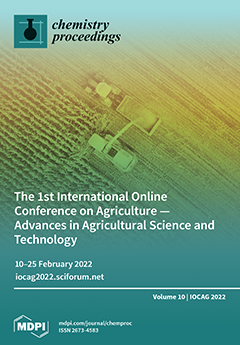A field experiment was carried out at the Experimental Station of Vytautas Magnus University Agriculture Academy in 2019–2020, in Lithuania. The aim of the study was to determine and to compare weed spread and caraway (
Carum carvi L.) crop productivity in sole (spring barley, spring wheat, pea, caraway), binary (spring barley–caraway, spring wheat–caraway, pea–caraway) and trinary (spring barley–caraway–white clover, spring wheat–caraway–white clover, pea–caraway–white clover) crops. We hypothesized that the application of a multi-cropping system would inhibit the spread of weeds and increase the productivity of caraway crop. Objectives: (1) to determine the weed species composition in multi-cropping (sole, binary, and trinary) systems; (2) to determine the number and dry biomass of weeds in multi-cropping (sole, binary, trinary) systems; (3) to evaluate the yield of caraway seeds grown in multi-cropping systems. The dry biomass of weeds was established before harvesting the main crop (spring barley, spring wheat, and pea) (2019), and during the second year (2020) of caraway vegetative season—before harvesting caraway and spring barley in 10 randomly selected sites of 0.06 m
2 in each harvested plot. The number and species composition of the weeds were determined in the laboratory, and the weeds were dried in an oven at 60 °C and weighed. The number of weeds was recalculated to pcs. m
−2 and the dry biomass to g m
−2. Caraway seed yield calculation was based on a standard 12% moisture content and absolutely clean seed content (t ha
−1). In the first year of caraway vegetative season (2019), 23 weed species were found in multi-crops, including 19 annual weeds and 4 perennial ones. The weeds found belong to 11 different families. Two annual dicotyledonous weed species predominated: white goosefoot (
Chenopodium album L.) and scentless chamomile (
Tripleurospermum perforatum (Merat) M. Lainz). In the second year of the caraway vegetative season (2020), 22 weed species were found in multi-crops systems, including 18 annual weeds and 4 perennial ones. The weeds found belong to 11 different families. Scentless chamomile (
Tripleurospermum perforatum (Merat) M. Lainz) and common dandelion (
Taraxacum officinale F.H. Wigg.) were dominant in binary and trinary crops. Significantly higher yield of caraway seed, from 1.7 to 3.7 times, was formed when it was grown after pea, compared to other crops.
Full article



